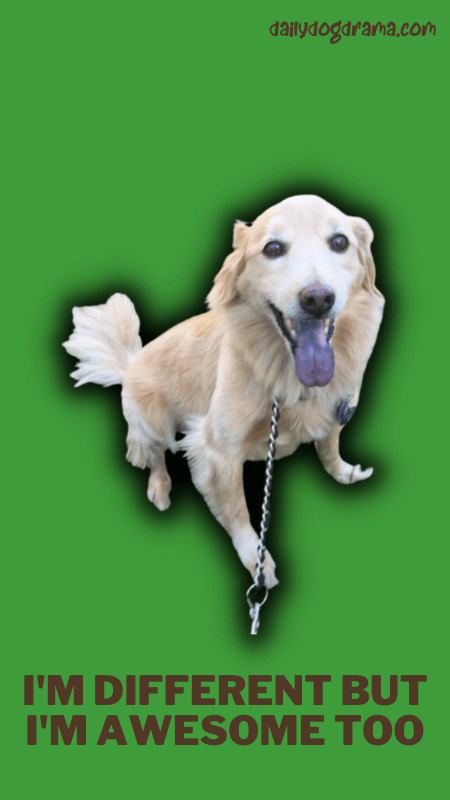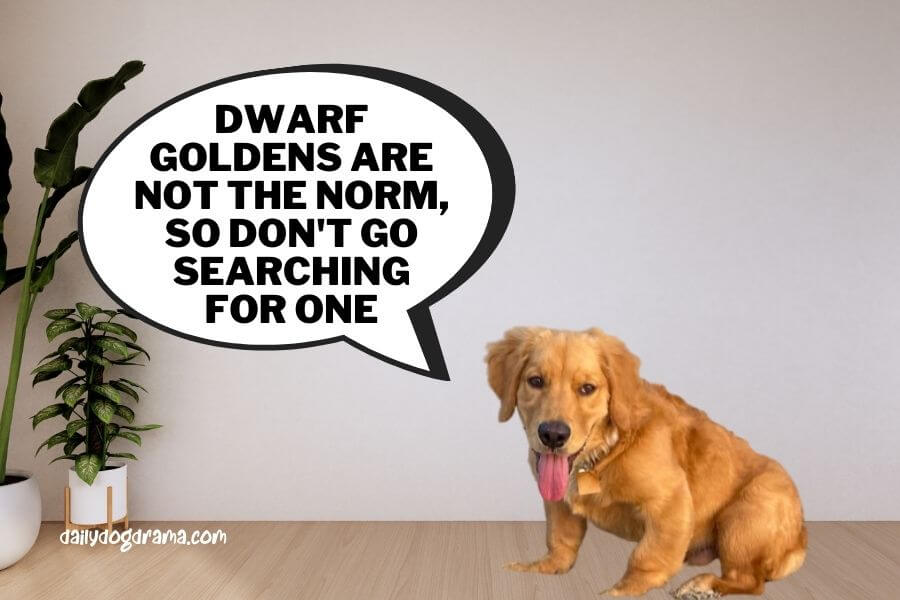Do you know what DOG ESSENTIALS you are missing out? Find out now!
Zack Keithy, our author, is a certified veterinarian technician (UC Blue Ash) for over 6 years (contact him here). The articles written here are based on his expertise and experience, combined with a review by our expert vet reviewers including Dr M. Tarantino. Learn more about us here.
Some people might just think that the short goldens they see are simply mini goldens, but that is not always true.
In some rare cases, what you might be seeing is golden retriever dwarfism, where the purebred Golden is crossed with Poodle, and sometimes a Cocker Spaniel to create a crossbreed.
In this post, you will learn more about this unique dog breed, how to identify it, and care options if you are an owner.
Medical Questions? Talk to a Veterinarian 24/7.
Connect one-on-one with a licensed vet who will answer your questions in minutes.
*Article may contain affiliate links to retailers like Amazon and Chewy. Learn more on our disclosure page.
- What is a Dwarf Golden Retriever?
- What Are the Signs of Dwarfism?
- How Long Do Dogs Live With Dwarfism?
- Dwarf Golden Retriever Health
- Can Dwarfism Be Treated?
- What Are the Differences Between a Mini Golden Retriever and a Dwarf Golden Retriever?
- Dwarf Golden Retriever Mixes
- In Conclusion: Golden Retriever Dwarfism
What is a Dwarf Golden Retriever?
It is pretty easy to spot a dog with dwarfism, you just have to notice if the legs are disproportionately shorter than the rest of the body.
However, it is way harder to see if a breed’s dwarfism is due to natural mutation or otherwise with the naked eye.
Although many dog breeds may have that in their genetic dispositions like the Corgis and Beagles, in the case of a Dwarf Golden Retriever breed, dwarfism is not natural to them.
Instead, they are bred intentionally by crossing them with a dog that has a natural dwarfism gene like the Miniature Poodles, Cocker Spaniels, Beagles, Dachshunds, Basset Hounds, and Corgis.
Doggy says, consider reading this too: Heinz 57 Dog Breed [All you wanted to know]
With that said, different crosses will breed different types of Dwarf Golden Retrievers.
This is why they may come in many sizes and forms.
More often than not, they have vastly different temperaments than a normal golden retriever too.
For instance, a Dachshund Golden Retriever mix may have a long coat just like a normal Golden Retriever’s, however it may also inherit the Dachshund’s naturally protective nature.
As such, they tend to be more aggressive towards strangers and are not as friendly as a Golden.
For a Corgi Golden Retriever mix, they may look more like a Corgi as the dwarfism mutation gene is a dominant one.
If you have a Beagle Golden Retriever, you may end up having a very vocal dog with a friendly attitude!
In other words, with a crossbreed Golden, you may be surprised at what you can get from the cross-breeding process!
What Are the Signs of Dwarfism?
To spot a dog with dwarfism, the easiest way would be to see if its legs are disproportionately shorter than the rest of the body.
Beyond that, there are a few more tell-tale signs you can look out for too to determine if your dog has this generic and hereditary dwarfism.
Apart from the Dwarf Golden Retriever which is not a pure breed on its own, many dogs like the Miniature Poodles, Cocker Spaniels, Beagles, Dachshunds, and Corgis share this common condition and are born with dwarfism.

Signs can be seen as early as 2 weeks of age for some dog breeds, where there is a delay in their growth spurt compared to other dogs.
A dog with dwarfism may be smaller in size, has a more stunted nose, and would probably still has its newborn puppy fur coat on.
If the signs were not too obvious then, by week 12 of your puppy’s life, you may be able to identify more signs like a misshapen bone structure also known as skeletal dysplasia, particularly on its head, face, or legs.
A dog with dwarfism may also have a larger than normal head, lack of teeth due to slow development, and its tongue sticking out of its mouth involuntarily.
It may also have a shorter jaw with an underbite where the upper teeth are lined behind the lower ones.
This may cause your puppy to snore more than the average pup.
Although all these signs and features may lead you to consider getting a dwarf dog breed, as after all, they do look way cuter than a normal-sized dog, the reality remains that with these dogs, their lifespans are tremendously shortened due to possible endocrine (hormonal) dysfunctions.
Your dog may develop conditions like hypothyroidism, osteoporosis due to weak and unhealthy bones from skeletal dysplasia, and heart diseases at an earlier age because of that.
How Long Do Dogs Live With Dwarfism?
Although dogs with dwarfism may look adorable and carefree at a glance, there are many underlying health problems that can cause them to have a shorter life span due to the delay in size and hormonal growth.
In fact, most dwarf dogs are sterile and unable to reproduce.
Typically, a dwarf dog may only live up to 10 years while some breeds like the German Shepherd and Basset Hound, which have a specific dwarfism condition called pituitary dwarfism, may have their life span shortened even further to just 3-4 years of their adolescent lives.
Dwarf dogs have a higher risk of developing rare disorders specific to their dwarfism mutation genes such as a deficiency in growth hormones interfering with the natural development of their kidneys and skeletal dysplasia, a dangerous form of abnormality in cartilage and bone growth, resulting in disproportioned bone and spine lengths.
As such, they may experience renal failure while an underactive thyroid may cause them hypothyroidism.
Overall, dwarf dogs may have a compromised immune system which makes them prone to heart, bone, and even hormonal diseases at an early age, leading to early death.
Dwarf Golden Retriever Health
A dwarf Golden Retriever is exposed to the same common problems that a regular Golden will face.
If you are unsure what they are, refer to the points here:
| Condition | Description |
|---|---|
| Hip & Elbow Dysplasia | Due to their significant growth spurts during puberty, which adds additional stress to their joints, Goldens are more likely to develop hip dysplasia, which is generally thought to be a genetic illness. |
| Cancer | Unfortunately, Golden Retrievers are almost twice as likely to develop cancer than other dog breeds, making it a frightening diagnosis. The two most frequent types of cancer in Golden Retrievers are hemangiosarcoma and lymphoma. They claim lives in about 60% of cases. |
| Cataracts | When a dog develops a cataract, the lens of the eye becomes partially or completely opaque, impairing its eyesight. Cataracts can result in complete blindness in the affected eye and often give the eye a cloudy, whitish appearance. Canines who have diabetes are more likely to get one or more cataracts. |
| Panosteitis | Large dog breeds like Golden Retrievers are more likely to develop panosteitis, which manifests as excruciatingly inflamed leg shafts. Lameness can result from panosteitis, which is thought to be a side consequence of the legs’ rapid growth. Due to their larger size, male dogs are more likely to be impacted than females. |
| Skin Conditions | Golden Retrievers have a beautiful coat, but it is also a hotbed for bacteria. Due to this, Golden Retrievers are more prone to seborrhea, environmental allergies, and sebum cysts, among other skin disorders. Even one in two Golden Retrievers is predicted to get skin issues at some point in their lives. |
| Aortic Stenosis and Heart Problems | One of the breeds of dogs most likely to develop aortic stenosis is the Golden Retriever. This condition sees the aortic valve of the heart narrow, making it more difficult for the body to flow blood through the valve. Heart failure and additional stress on the heart can result from aortic stenosis. |
Can Dwarfism Be Treated?
Dwarfism in dogs can be treated and managed with the right methods, diets, and medications although the treatments available at this point in time may not be able to extend your dog’s life expectancy to that of a normal breed house pet.
That said, treatment can certainly increase your dog’s quality of life.
When treated right, a dog with dwarfism may not have to end up getting euthanized at a young age.
Depending on the severity of your dog’s symptoms as it grows, the right vet will recommend suitable treatments targeting those problems as and when they arise.
It is highly recommended by veterinarians to spay or neuter your dog early if it is diagnosed with dwarfism.
Despite the low fertility rates due to their hormonal imbalance, female dwarf dogs tend to have heavier bleeding when in heat.
Coupled with irregular menstrual cycles, this can cause them to have more frequent urinary tract infections thus putting their lives at risk.
Treatment by using growth hormones is also another plausible choice.
It is however quite costly and may not always harvest good results.
It could also cause side effects like Diabetes Mellitus, which could lead to even more health complications in the future.
As dogs with Dwarfism tend to suffer from hypothyroidism, treatment using synthetic levothyroxine may be administered to replace the missing natural levothyroxine in your dog’s body.
However, if the dose is too potent for your dog, it could end up making it more anxious (usually treated with Ativan) and restless.
A dog with dwarfism may naturally become obese due to its short stature, so you will want to keep your dog healthy by putting it on a long-term diet.
Feed it only with high-quality dog food (especially no human snacks!).
You may consider bringing your dog for daily, long walks too to boost their cardio functions for a healthier life.
At the end of it all, dogs with dwarfism do require a lot more TLC for them to lead meaningful, happy lives.
You could help them by making adjustments to their lifestyle.
What Are the Differences Between a Mini Golden Retriever and a Dwarf Golden Retriever?

A Dwarf Golden Retriever is a hybrid cross between a purebred Golden Retriever with a dog of dwarfism genes.
Amongst others, many would cross a Golden with Corgis, Cocker Spaniels, Daschunds, Beagles, Basset Hounds, and even Miniature Poodles.
The result could vary in terms of size and temperament depending on which gene is more dominant.
Therefore a Golden could end up looking more like a Corgi with a longer, silkier coat among the many other possibilities.
On the other hand, Mini Goldens are mostly bred with pure-breed dogs like the Poodle breed and occasionally, Cocker Spaniels.
They are known by many aliases such as Comfort Retrievers, Golden Cocker Retrievers, or even Petite Golden Retrievers.
As a general rule, a Mini Golden Retriever would resemble a full-sized Golden Retriever in terms of angles and proportions but stand at a maximum of around 16 inches tall.
To get more specific, the name ‘Comfort Retriever’ Is trademarked only for breeds crossed between a purebred Golden Retriever and Poodles.
Minis are considered a new-age crossbreed as they only arrived on the scene in 2003.
Unlike Dwarf Golden Retrievers which may have many health complications due to their hormonal imbalances such as skeletal dysplasia, Mini Goldens are healthier although they may not be hypoallergenic.
If you suspect that your Golden Retriever might be a dwarf, you can use this kit to get it tested.
Dwarf Golden Retriever Mixes
Since the first hybrid mix between a Golden Retriever and a dog with dwarfism genes back in 2003, there have been many Dwarf Golden Retriever mixes.
Especially where multi-generational crosses are concerned, you will probably end up having a dog with very vast temperaments and physical features.
Generally, you could cross a Golden Retriever with a Corgi, Daschund, Beagle, Poodle, or Basset Hound amongst others.
A golden retriever mix with Dachshund is called a Golden Dox.
Physically, it will have longer ears.
Character-wise, it is independent and lively, to say the least.
It is also one that would most likely love doing its own things.
This mix needs a lot of attention from its owner to stay happy.
A Golden Corgi tends to be more sociable, loves company, and are more intelligent.
Other less famous mixes are the Goldenshire (Golden mix Yorkshire Terrier) and Golden Chi (Golden mix Chihuahua).
For the former, they tend to be more easy-going and friendly, are smart, and learn commands quickly, making them well suited for a family setting.
A Golden Chi has a cheerful outgoing nature with a stubborn streak.
It may have a lot more energy than a pure breed dog and therefore may not respect boundaries.
Popular or unpopular opinion? Poodles are ugly?
In Conclusion: Golden Retriever Dwarfism
Does your Golden Retriever have dwarfism? Or do you suspect it might have it?
You can use a DNA testing kit to get the answers, but no matter what the outcome is, you should shower it with plenty of love and attention.
That way, it will be a happy dog despite the challenges it will face in its life.



